Report: 75% of N.C. Suffering From Drought
More than three-quarters of North Carolina is suffering from drought conditions, and several western counties are extremely dry, according to climate figures released Thursday.
Posted — UpdatedNorth Carolina's seven westernmost counties – Cherokee, Clay, Graham, Haywood, Jackson, Macon and Swain – face the worst conditions, according to the U.S. Drought Monitor, a government report. It also said all counties west of Interstate 26 face severe drought conditions.
State climatologist Ryan Boyles said North Carolina is facing its worst water shortage since 2002, which could leave the state vulnerable to worsening conditions as the summer approaches.
"It has been creeping up on us slowly for the past several weeks," Boyles said. "Now we're starting to see impacts on our agriculture and water management."
Local governments across the state are urging – and in some cases mandating – residents to conserve water. Gov. Mike Easley has directed state agencies in 17 counties in the western part of the state to stop nonessential water use.
State officials list crops corn, soybeans, sweet potatoes and cotton as distressed by state officials because of the lack of rains. The tobacco crop hasn't been affected so far, officials said.
Cumberland County farmer Collins Bullard said he expects to lose at least half of his wheat crop and is trying to save as much of his watermelon crop as possible through irrigation.
"If we do get some rain within the next 10 days, it will help sustain what we've got out now," said Colby Lambert, a Cumberland County agent for the North Carolina Cooperative Extension Service.
Dry weather across the Southeast has triggered wildfires in Georgia and Florida, where Lake Okeechobee's water levels dropped to a record low Thursday.
Michael Good, a district manager for the North Carolina Forestry Service, said his office gets five to six calls about wildfires every day.
"We're having to respond to fires that we wouldn't normally have to respond to," Good said, adding that people who burn outdoors need to hose down the area when they're done so fires don't smolder and spread.
Asheville has seen 11.82 inches of rain since the beginning of the year, more than 8 inches off its average, according to the National Weather Service.
Rainfall in the Triad region has totaled 0.54 inches for May, which would mark the third-driest May on record and the driest since 1954, the weather service said. The area in 3.7 inches below average for rainfall since the beginning of the year. In the Triangle, rainfall is 4.3 inches below average.
Jeff Orrock, a forecaster with the National Weather Service in Raleigh, said the state likely won't see any significant rain until after the weekend – and there's no guarantee that a new system will bring much precipitation.
"However, the good news is that there will be a pattern change," Orrock said, noting that a high-pressure system that's kept rain away will soon begin moving after remaining anchored over the East Coast for about two weeks.
Copyright 2024 by WRAL.com and the Associated Press. All rights reserved. This material may not be published, broadcast, rewritten or redistributed.





